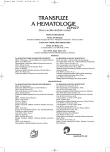Production and use of blood components in Czech Republic in the year 2006
Authors:
P. Turek
Authors‘ workplace:
Fakultní Thomayerova nemocnice s poliklinikou, Praha
Published in:
Transfuze Hematol. dnes,13, 2007, No. 3, p. 159-163.
Category:
Comprehensive Reports, Original Papers, Case Reports
Overview
Blood transfusion service in the Czech Republic is disperse, hospital based. Overall 55 blood establishments plus 14 blood collection centres took part in the production of allogeneic blood components and plasma for fractionation. These establishments together with another 42 blood banks substitute hospitals with blood components. Blood is collected mostly from voluntary non-remunerated blood donors. Donor population is stable and relatively safe. Predeposit autologous programme is popular. Production of blood components is stable over the years, country is self-sufficient in blood components and plasma for fractionation. Circa 40 red blood cell units per 1000 inhabitants are available, platelets and fresh frozen plasma for clinical purposes are available. Over 80 tons of plasma are sent for industrial fractionation. Transfusion policy differs in different hospitals even if recommendations based on expert opinion are available for clinical use of blood. Severe adverse effects of transfusion are relatively rare.
Key words:
Czech Republic, blood transfusion service, blood components, production, consumption, adverse reactions to transfusion
Sources
1. Turek P. Produkce transfuzní služby ČR 1990–1999. Transfuze dnes 2000; 3: 91–95.
2. Turek P. Produkce transfuzní služby ČR v r. 2002. Trans Hemat dnes 2003; 2: 73–74.
3. Turek P, Masopust J. Produkce transfuzní služby v České republice v roce 2003. Trans Hemat dnes 2004; 3: 122–128.
4. van der Poel C, Jansen M, Behr-Gross ME. The collection, testing and use of blood and blood products in Europe in 2004. EDQM 2007, Council of Europe
5. Rouger P. (ed): Blood transfusion in Europe. The white book 2005, Paris, Elsevier, 2006.
6. Rožman P, Domanovic D. Transfusion medicine in Slovenia, Current status and future challenges. Transfus Med Hemother 2006; 33(5): 420–426.
7. Schennach H, et al. Transfusion medicine in Austria. Transfus Med Hemother 2006; 33(5): 364–373.
8. Levy G, et al. Transfusion medicine in Switzerland. Transfus Med Hemother 2006; 33(5): 393–400.
9. Antoniewicz-Papis J, Letowska M. The Polish blood transfusion service – quality, guidelines, laws, selected topics of interest and future challenges. Transfus Med Hemother 2006; 33(5): 401–406.
10. Barotine-Toth K, Hoffer I. Hungarian National Blood Transfusion Service. Transfus Med Hemother 2006; 33(5): 415–419.
Labels
Haematology Internal medicine Clinical oncologyArticle was published in
Transfusion and Haematology Today

2007 Issue 3
Most read in this issue
- G-CSF in healthy donors. Safe or harmful?
- CTD regimen (cyclophosphamide, thalidomide, dexamethasone) in the treatment of relapsed or refractory multiple myeloma
- Clinical value of 18F-FDG-positron emission tomography in follicular lymphoma
- Production and use of blood components in Czech Republic in the year 2006
